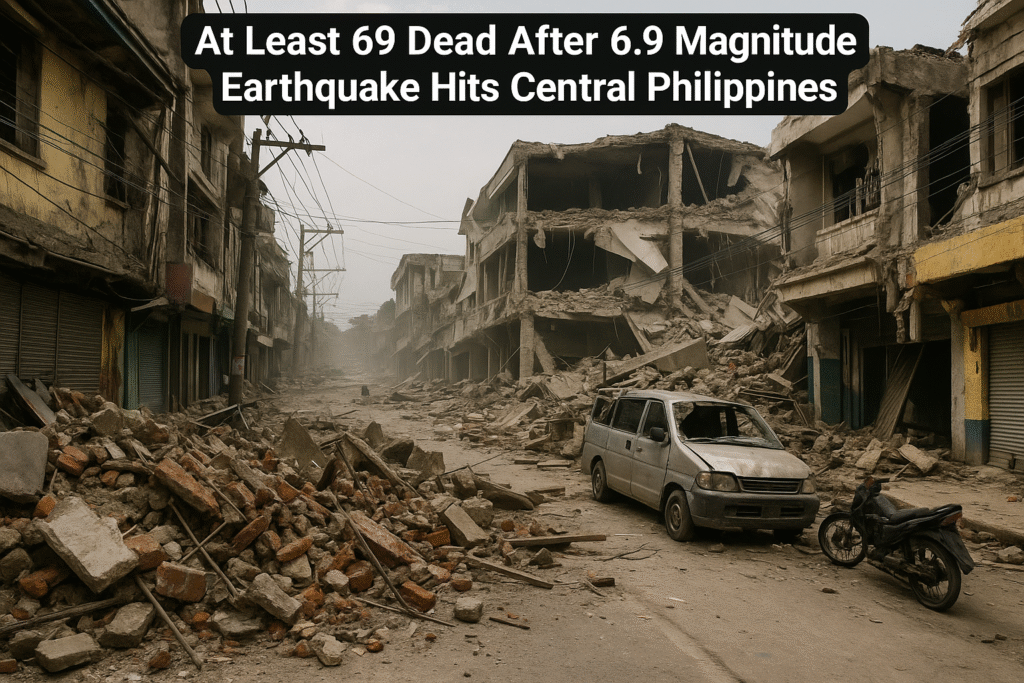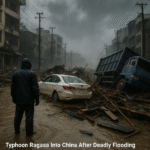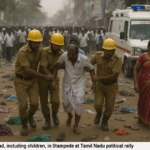By Harshit, October 1, 2025 | Cebu, Philippines | 11:00 AM
Central Philippines Hit by Major Earthquake
At least 69 people have died and dozens more have been injured after a powerful 6.9 magnitude earthquake struck the central Philippines late on Tuesday. The hardest-hit area is Cebu province, where thousands spent the night on streets amid repeated aftershocks, with power and water cut off in many locations.
Authorities in Cebu declared a state of calamity on Wednesday as emergency responders scrambled to provide medical aid, restore utilities, and assess the full scope of the damage. The quake comes barely more than a week after the country was hit by back-to-back typhoons—Bualoi and Ragasa—which together killed more than a dozen people and displaced hundreds of thousands.
Bogo City Suffers Heaviest Losses
Most casualties occurred in Bogo City, a small town on one of the Visayas Islands closest to the earthquake’s epicenter. Residents reported streets lined with cadaver bags, tent hospitals overflowing with the injured, and widespread structural damage. Officials have warned that the true toll may rise as assessments continue.
Seven victims lived in a village built to house survivors of Typhoon Haiyan, the catastrophic storm that struck the central Philippines 12 years ago, killing over 6,000 people.
In San Remigio municipality, an ongoing basketball game was interrupted by the quake. Emergency responders rushed nearly 20 attendees to hospital, with at least one later dying from injuries.
Aftershocks and Infrastructure Damage
Following the main quake, Cebu experienced another aftershock on Wednesday evening measuring 4.7 in magnitude. Tremors were felt in Cebu City and neighboring Leyte islands, though no casualties have been reported from this aftershock so far.
Buckled roads, collapsed bridges, and downed power lines are complicating emergency efforts. Communication with affected towns has been difficult, prompting authorities to appeal for volunteers with medical experience to assist with rescue operations.
The archbishop of Cebu advised the public to avoid churches until structural assessments are complete, citing concerns over the safety of many historic structures. Several old Catholic churches, some dating back to the 1500s, suffered damage, including a partial collapse of a bell tower captured in early footage.
National Response and Risk Factors
The Philippines’ national disaster agency, based in Manila, continues to coordinate the response. Official casualty figures are often delayed due to verification processes, meaning the death toll is expected to rise.
The country is highly vulnerable to natural disasters. Located in the geologically active “Ring of Fire,” the Philippines experiences frequent earthquakes and volcanic eruptions due to the movement of tectonic plates in the Pacific region. The nation also lies in the path of seasonal typhoons, which sweep across the islands every year.
This earthquake compounds an already challenging situation for residents who were recently impacted by Typhoon Bualoi and Typhoon Ragasa. Last month, these storms killed over a dozen people and forced hundreds of thousands into evacuation centers. Some individuals remain missing following the typhoons, highlighting the ongoing vulnerability of the region to consecutive disasters.
Search, Rescue, and Relief Efforts
National police and fire authorities have prioritized search-and-rescue operations, rapid restoration of electricity, and distribution of relief supplies. Emergency teams are working under difficult conditions, with damaged roads and ongoing aftershocks impeding access to the most affected areas.
Local and international aid agencies have also mobilized to support the relief effort, focusing on food, medical care, and temporary shelter for displaced families. Authorities have stressed the need for additional volunteers, particularly those with medical expertise, to assist overwhelmed hospitals and makeshift treatment centers.
Looking Ahead
As aftershocks continue and rescue operations proceed, authorities warn that the death toll could rise significantly. The combination of back-to-back natural disasters—including recent typhoons and this earthquake—has left communities in central Philippines facing widespread devastation, interrupted utilities, and heightened humanitarian needs.
Officials continue to urge caution, urging residents to avoid structurally compromised buildings and maintain vigilance during aftershocks. Relief agencies are coordinating to provide urgent assistance while assessing the long-term reconstruction needs of affected areas.







